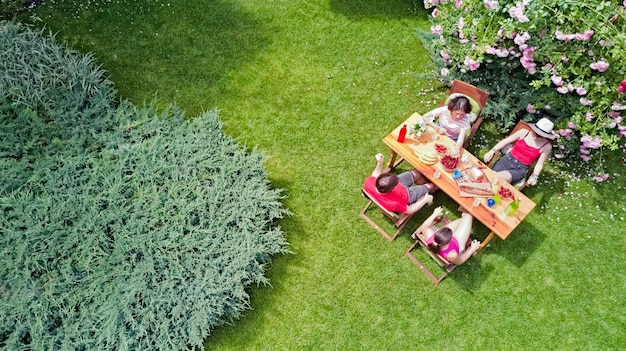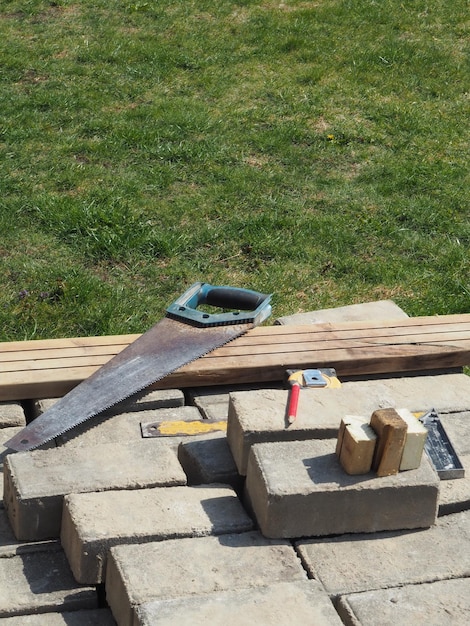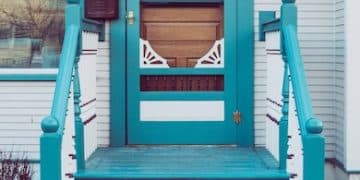Extend Your Living Space: Build a Patio for Under $5,000

Extending your living space by building a patio for under $5,000 is achievable through careful planning, DIY efforts, and smart material choices, significantly enhancing your outdoor living experience and potentially increasing your home’s value.
Looking to enhance your home without breaking the bank? You can extend your living space: build a patio for under $5,000 and increase home value. Creating an inviting outdoor area is more accessible than you might think.
Planning Your Budget-Friendly Patio Project
Creating a patio doesn’t have to be an expensive endeavor. Careful planning and smart material choices are key to staying within a $5,000 budget. Let’s break down the essential steps to get you started.
Determining the Patio Size and Location
The size of your patio significantly impacts the overall cost. Consider how you plan to use the space. A small, intimate seating area requires less square footage than a large dining and entertainment space. The location also plays a crucial role. Evaluate the existing landscape, accessibility from the house, and sun exposure. Choosing a level area close to your house will minimize excavation and material costs.
Choosing the Right Materials
Material selection is vital for both cost and aesthetic appeal. Concrete, pavers, and gravel are popular options for affordable patios. Concrete slabs are a durable and low-maintenance choice, while pavers offer a more decorative look at a slightly higher cost. Gravel is the most budget-friendly option, providing a rustic charm if properly contained and maintained.

- Concrete Slabs: Cost-effective, durable, and easy to install.
- Pavers: Offer a wide range of design options and can be installed DIY.
- Gravel: The most affordable choice, providing good drainage and a rustic look.
Remember to factor in the cost of base materials, such as crushed stone, which are essential for proper drainage and patio stability. Research local suppliers to compare prices and consider purchasing in bulk to save money.
Careful planning of the size, location, and materials will allow you to create a beautiful outdoor extension of your home while staying within budget.
DIY vs. Professional Installation: Which is Right for You?
Deciding whether to DIY or hire a professional installer is a crucial decision that can significantly impact both the cost and the outcome of your patio project. Let’s weigh the pros and cons of each option.
The Pros and Cons of DIY Installation
DIY installation can save a considerable amount of money on labor costs. If you’re handy and willing to put in the work, you can complete the project for the cost of materials alone. However, DIY requires a significant time investment, physical effort, and some degree of skill. Mistakes can be costly to fix, so it’s essential to assess your abilities honestly.
When to Hire a Professional
Hiring a professional installer ensures the job is done correctly and efficiently. Professionals have the experience and equipment to handle complex installations, such as those involving significant excavation or intricate paver patterns. While the upfront cost is higher, professional installation can save you time, stress, and potential repair costs in the long run.

- DIY: Significant cost savings, requires time and effort, risk of errors.
- Professional Installation: Higher upfront cost, ensures quality and efficiency, saves time and stress.
- Hybrid Approach: Combine DIY and professional help for cost-effective results.
A hybrid approach is another option. You can handle the demolition and site preparation yourself to save on labor costs, then hire a professional for the actual patio installation. This allows you to control costs while ensuring the critical aspects of the project are handled by experts.
Whether you choose DIY or professional installation depends on your budget, skills, and time constraints. Weigh the pros and cons carefully to make the best decision for your patio project.
Choosing the Right Patio Materials Under $5,000
Selecting the right materials is essential for building a patio that looks great and stays within your budget. Affordable materials like concrete, gravel, and interlocking pavers offer a variety of options to consider.
Concrete: Durable and Versatile
Concrete is a popular choice for patios due to its durability and versatility. Poured concrete provides a smooth, seamless surface that’s easy to maintain. Concrete pavers, on the other hand, offer more design flexibility and can mimic the look of natural stone at a fraction of the cost. Consider staining or stamping concrete to add visual interest and customize the look of your patio.
Gravel: A Budget-Friendly Option
Gravel is the most affordable patio material, making it an excellent choice for budget-conscious homeowners. Crushed stone or decomposed granite can create an attractive, rustic patio surface. However, gravel requires regular maintenance to keep it looking tidy. Using edging materials like wood or metal can help contain the gravel and prevent it from spreading.
Interlocking Pavers: Style and Affordability
Interlocking pavers offer a balance of style and affordability. These pavers come in a variety of shapes, colors, and patterns, allowing you to create a custom patio design without breaking the bank. Interlocking pavers are relatively easy to install, making them a good choice for DIY projects. They also provide good drainage and are resistant to cracking.
When selecting patio materials, consider the overall style of your home and garden. Choose materials that complement the existing landscape and reflect your personal taste.
Essential Tools and Equipment for a DIY Patio Project
If you decide to take on your patio project as a DIY endeavor, having the right tools and equipment is essential for a smooth and successful installation. Here’s a list of necessary tools and equipment.
Hand Tools
A variety of hand tools are essential for any DIY patio project. These include a shovel for digging and moving materials, a rake for leveling surfaces, a hand tamper or plate compactor for compacting the base materials, a level for ensuring a flat and even surface, and a measuring tape for layout and measurements.
Power Tools
While hand tools are important, power tools can significantly speed up the installation process. A circular saw or paver cutter is necessary for cutting pavers or concrete slabs to size. A power drill is helpful for installing edging materials or constructing retaining walls. A plate compactor is essential for properly compacting the base materials, ensuring a stable and level patio surface.
“`html
“`html
- Shovel: For digging and moving materials.
- Rake: For leveling the base surface.
- Hand Tamper/Plate Compactor: For compacting base materials.
Safety Gear
Safety should always be a priority when working on any DIY project. Wear safety glasses to protect your eyes from flying debris. Use work gloves to protect your hands. Wear a dust mask when working with concrete or gravel to avoid inhaling harmful particles. Steel-toed boots are recommended to protect your feet from injury.
Having the right tools and equipment not only makes the job easier, but also ensures a higher quality finished product. Invest in quality tools and take the time to learn how to use them properly.
Landscaping and Decorating Your New Patio
Once your patio is built, it’s time to transform it into a welcoming and enjoyable outdoor space. Landscaping and decorating are key to creating a patio that reflects your personal style and enhances your outdoor living experience.
Adding Greenery and Plants
Incorporate greenery and plants to create a lush and inviting atmosphere. Potted plants are an easy way to add color and texture to your patio. Choose plants that thrive in your local climate and require minimal maintenance. Consider adding a vertical garden or hanging baskets to maximize space and add visual interest. Trees and shrubs can provide shade and privacy, making your patio more comfortable and secluded.
Choosing the Right Furniture
Select furniture that is both comfortable and durable. Outdoor furniture made from weather-resistant materials like teak, aluminum, or resin wicker is a good choice. Choose furniture that complements the style of your home and garden. Comfortable seating, such as lounge chairs or sofas, is essential for relaxation. Add an outdoor dining table and chairs for al fresco meals. Consider adding an outdoor rug to define the seating area and add warmth.
Lighting and Ambiance
Lighting can transform your patio into a magical space at night. String lights or fairy lights add a warm and inviting glow. Solar-powered lanterns are an energy-efficient option. Consider adding spotlights to highlight architectural features or landscaping elements. An outdoor fireplace or fire pit can create a cozy and inviting atmosphere for cooler evenings.
By carefully landscaping and decorating your patio, you can create an outdoor space that enhances your home and your lifestyle. Choose elements that reflect your personal style and make your patio a place you love to spend time.
Maintaining and Upgrading Your Patio Over Time
Proper maintenance is essential to keep your patio looking its best and to extend its lifespan. Simple maintenance tasks can prevent costly repairs and ensure your patio remains a beautiful and functional outdoor space for years to come.
Regular Cleaning
Regular cleaning is key to preventing dirt, stains, and mildew buildup. Sweep your patio regularly to remove leaves, dirt, and debris. Use a garden hose to wash away loose dirt and stains. For tougher stains, use a mild detergent and a scrub brush. Pressure washing can be effective for removing stubborn stains, but be careful not to damage the surface of your patio. Always follow the manufacturer’s instructions for cleaning specific materials.
Repairing Cracks and Damage
Inspect your patio regularly for cracks, chips, or other damage. Repair small cracks with concrete patching compound. Replace damaged pavers or concrete slabs as needed. Address drainage issues promptly to prevent water damage. Consider sealing your patio every few years to protect it from the elements.
- Regular sweeping: Prevents dirt and debris buildup.
- Mild detergent cleaning: Removes tough stains.
- Crack repair: Prevents further damage.
Upgrading Your Patio
Over time, you may want to upgrade your patio to enhance its functionality and appearance. Consider adding new landscaping elements, such as plants, trees, or shrubs. Replace outdated furniture with modern and comfortable pieces. Add an outdoor kitchen or bar area for entertaining. Consider installing a pergola or awning to provide shade and shelter.
By following these maintenance and upgrade tips, you can ensure your patio remains a beautiful and functional outdoor space for years to come.
| Key Point | Brief Description |
|---|---|
| 💰 Budget Planning | Careful planning ensures staying under $5,000. |
| 🛠️ DIY vs. Pro | Decide based on skills, time, and budget. |
| 🌱 Landscaping | Adds greenery and ambiance for appealing space. |
| 🧹 Maintenance | Regular cleaning and repairs extend patio life. |
“`html
Frequently Asked Questions
▼
Gravel is the most economical option for building a patio, offering a rustic aesthetic at a fraction of the cost compared to concrete or pavers, and it provides good drainage.
▼
Start by removing sod and topsoil, then level the area using a rake. Compact the soil with a hand tamper or plate compactor, and add a layer of crushed stone for drainage and stability.
▼
Yes, many homeowners successfully build patios themselves, especially with materials like gravel or interlocking pavers. DIY installation saves on labor costs, but requires time, effort, and some basic skills.
▼
A well-designed and maintained patio enhances your outdoor living space, making your home more appealing to buyers. Adding features like an outdoor kitchen can further boost its value.
▼
Opt for materials like concrete or composite decking, which require minimal upkeep. Incorporate drought-resistant plants and use gravel or mulch to reduce weeding and watering needs.
“`html
Conclusion
Transforming your outdoor space with a new patio doesn’t require a huge investment. By carefully planning your project, choosing cost-effective materials, and considering a DIY approach, you can extend your living space: build a patio for under $5,000 and increase home value, thus creating a beautiful and functional area for relaxation and entertainment.





